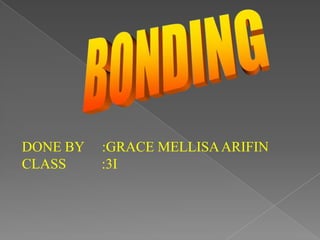
Formation of Covalent Bonds Explained in 40 Characters
- 1. DONE BY :GRACE MELLISA ARIFIN CLASS :3I
- 2. Using ‘dot-and-cross’ diagrams: The formation of covalent bonds between non- metallic elements
- 4. In covalent bonding, atoms still want to achieve a noble gas configuration (the octet rule).
- 5. In covalent bonding, atoms still want to achieve a noble gas configuration (the octet rule). But rather than losing or gaining electrons, atoms now share an electron pair.
- 6. In covalent bonding, atoms still want to achieve a noble gas configuration (the octet rule). But rather than losing or gaining electrons, atoms now share an electron pair. The shared electron pair is called a bonding pair
- 7. Chlorine forms covalent a Cl2 bond with itself
- 8. How will Cl Cl two chlorine atoms react?
- 9. Cl Cl Each chlorine atom wants to gain one electron to achieve an octet
- 10. Cl Cl Neither atom will give up an electron – chlorine is highly electronegative. What’s the solution – what can they do to achieve an octet?
- 11. Cl Cl
- 12. Cl Cl
- 13. Cl Cl
- 14. Cl Cl
- 15. Cl Cl octet
- 16. Cl Cl octet circle the electrons for each atom that completes their octets
- 17. Cl Cl The octet is achieved by each atom sharing the electron pair in the middle circle the electrons for each atom that completes their octets
- 18. Cl Cl The octet is achieved by each atom sharing the electron pair in the middle circle the electrons for each atom that completes their octets
- 19. Cl Cl This is the bonding pair circle the electrons for each atom that completes their octets
- 20. Cl Cl It is a single bonding pair circle the electrons for each atom that completes their octets
- 21. Cl Cl It is called a SINGLE BOND circle the electrons for each atom that completes their octets
- 22. Cl Cl Single bonds are abbreviated with a dash circle the electrons for each atom that completes their octets
- 23. Cl Cl This is the chlorine molecule, Cl2 circle the electrons for each atom that completes their octets
- 24. O2 Oxygen is also one of the diatomic molecules
- 25. O O How will two oxygen atoms bond?
- 26. O O Each atom has two unpaired electrons
- 27. O O
- 28. O O
- 29. O O
- 30. O O
- 31. O O
- 32. O O
- 33. O O Oxygen atoms are highly electronegative. So both atoms want to gain two electrons.
- 34. O O Oxygen atoms are highly electronegative. So both atoms want to gain two electrons.
- 35. O O
- 36. O O
- 37. O O
- 38. O O
- 39. O O Both electron pairs are shared.
- 40. O O 6 valence electrons plus 2 shared electrons = full octet
- 41. O O 6 valence electrons plus 2 shared electrons = full octet
- 42. O O two bonding pairs, making a double bond
- 43. O O O =O For convenience, the double bond can be shown as two dashes.
- 44. O =O This is the oxygen molecule, this is so cool! O2 !
- 46. CRED
